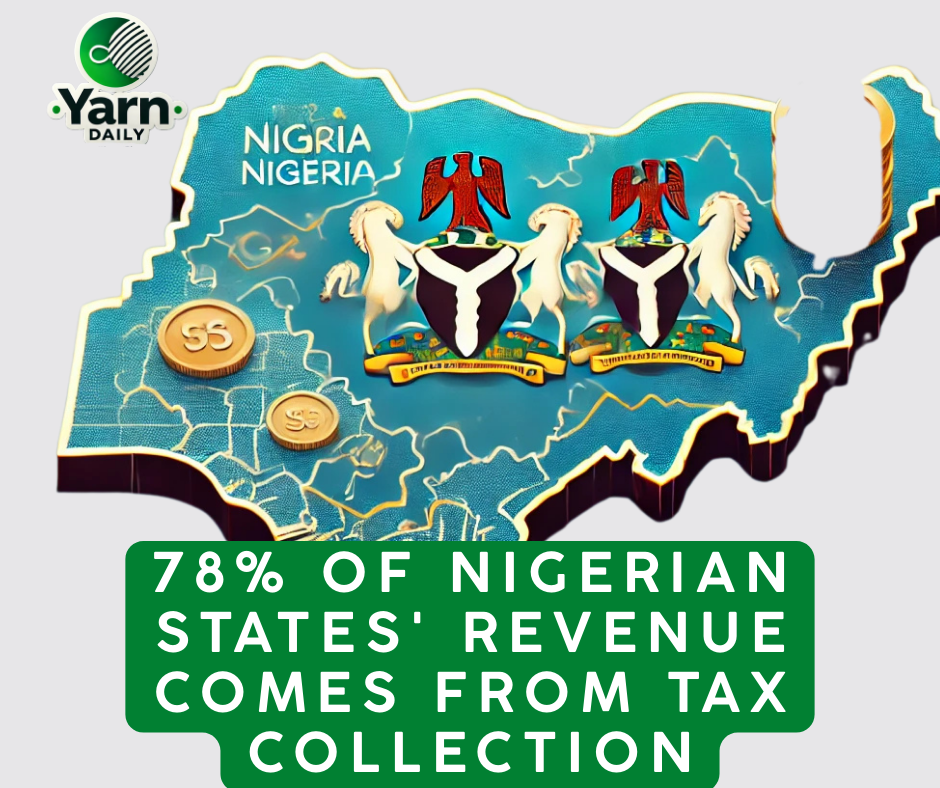
78% of Nigerian States’ Revenue Comes from Tax Collection
The economic well-being of any state largely hinges on its ability to generate internal funds for development, especially given the complex fiscal challenges facing countries like Nigeria. In 2023, the Internally Generated Revenue (IGR) for Nigeria’s 36 states and the Federal Capital Territory (FCT) reflected impressive growth, painting a vivid picture of resilience, diversity, and economic ingenuity across different regions.
According to the 2023 report compiled by the Joint Tax Board, Nigerian states and the FCT generated a total of N2.43 trillion, up 26.03% from the N1.93 trillion collected in 2022. An analysis of the data reveals some eye-opening figures—about 78% of the total revenue came from taxation alone, highlighting the critical role that effective tax administration plays in maintaining the economic stability of Nigerian states.
Breaking Down Revenue Sources: Taxation Takes the Lead
Taxation in its various forms contributes heavily to the IGR. From the analysis, approximately N1.24 trillion was collected through Pay As You Earn (PAYE) schemes, representing 63.83% of all tax revenue. This highlights the formal sector’s importance in boosting state revenue, despite challenges like evasion and enforcement struggles that persist in some parts of the country.
Other forms of taxes—including direct assessments, road taxes, and stamp duties—contributed significantly to the total earnings. MDAs (Ministries, Departments, and Agencies) also played their role, accounting for revenue generated through administrative fees for services like land registration, levies, and gaming fees. These MDAs contributed around N478 billion, about 19.7% of the total IGR.
The Top Performers: Lagos, FCT, and Rivers
Lagos State continued to lead the pack by generating a staggering N815.86 billion. Not only does Lagos contribute about 33.6% of the entire IGR in Nigeria, but its performance also shows a marked improvement in leveraging a diverse range of revenue sources, from corporate taxes to administrative fees collected by its MDAs.
Following Lagos, the FCT generated N211.10 billion, leveraging its unique status as the country’s administrative and political center. Rivers State, with N195.41 billion, maintained a solid third position. The state capitalized on its strong oil base, which drives both direct business taxes and MDAs’ earnings.
Lagging Behind: The Least Contributors
In stark contrast, states like Taraba, Yobe, and Kebbi had the least earnings, recording N10.87 billion, N11.19 billion, and N11.74 billion, respectively. These states face challenges such as inadequate infrastructure, a narrow tax base, and economic instability. The figures suggest a significant disparity in the economic activities across different parts of the country, with poorer regions struggling to generate as much revenue as their wealthier counterparts.
An Uneven Playing Field
The stark difference between states like Lagos and those trailing behind underlines one critical issue—Nigeria’s economic landscape is deeply uneven. Urbanized and industrial states enjoy access to a broader tax base, a more formal economy, and greater enforcement capabilities. In contrast, states with agrarian economies find themselves hampered by the informality of their economic activities.
PAYE Dominates the Tax Revenue
As previously noted, PAYE remained the leading source of tax income, accounting for N1.24 trillion. The high contribution from PAYE underscores a key strength for states like Lagos, where a robust formal employment sector and strong tax enforcement ensure compliance. Capital gains taxes, on the other hand, represented the least amount of tax collected, bringing in just N5.91 billion, which indicates room for improvement in capturing value from capital transactions.
Insights into MDAs Revenue
Revenue generated by MDAs also played a significant role, albeit not as large as tax revenues. Ogun State was notable for generating a high percentage of its revenue from MDAs—about N75.20 billion. This achievement can be attributed to the efficiency in collecting administrative fees for services like land transactions and other essential permits that drive public services.
Regional Insights and Policy Implications
One of the major takeaways from the 2023 IGR report is the need for tailored fiscal policies that address the unique challenges of individual states. States with strong industrial bases like Lagos, Rivers, and the FCT continue to dominate the IGR rankings, while others struggle with less dynamic economies.
Several opportunities exist to boost revenue generation in underperforming states, such as expanding the tax net to include the informal sector more effectively and enhancing MDAs’ ability to generate revenue through digitalization and automation. States like Kwara have showcased innovative revenue practices by leveraging exceptional items like pilgrim fees, a sign that niche revenue streams can significantly impact state earnings.
Why These Figures Matter
Internally Generated Revenue is the most sustainable means for states to fund their activities, from infrastructure to social services. Heavy reliance on federal allocations leaves states vulnerable to fluctuations in global oil prices, which largely fund Nigeria’s central budget. The 26.03% growth in 2023, especially in a challenging economic environment, reflects a commendable effort by states to shore up their finances.
Moving Forward: Improving Fiscal Stability
For Nigeria to achieve fiscal stability and improved economic welfare across the board, it’s imperative that all states focus on diversifying their revenue sources and ensuring better compliance within the existing tax frameworks. Encouraging the digitization of tax collection processes, offering incentives to businesses to formalize their operations, and prioritizing investment in infrastructure can help boost IGR.
Another area of improvement is ensuring transparency and minimizing leakages. With better use of technology, particularly blockchain and automated systems, states can effectively reduce corrupt practices that hamper tax collection efforts and build greater trust in the system among taxpayers.
The Path Ahead: Bridging the Gap
The massive disparity in revenue between top-performing states like Lagos and those at the bottom, such as Taraba and Kebbi, is concerning. There is a need for equitable policies that enable growth opportunities for all regions, ensuring a fair distribution of investments and resources. The federal government and international partners must also continue to support economically weaker states, providing them with both financial aid and technical support to improve their revenue mobilization strategies.
Moreover, building taxpayer trust is crucial. Citizens are more likely to comply with tax obligations when they see clear returns in terms of public services and infrastructure. Therefore, revenue collection efforts must be paired with visible improvements in governance and service delivery.
Conclusion
The 2023 IGR figures reveal a mix of successes and challenges for Nigeria’s states. While leading states like Lagos and Rivers showcase the potential of well-implemented revenue strategies, the lagging states underscore the need for more comprehensive support and innovative approaches. By understanding these dynamics, stakeholders can work towards creating a more balanced economic environment across Nigeria, benefiting both the citizens and the states in the long run.




